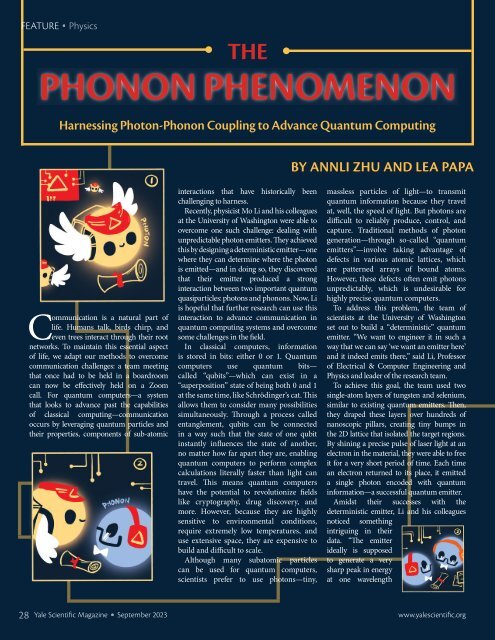YSM Issue 96.3
Create successful ePaper yourself
Turn your PDF publications into a flip-book with our unique Google optimized e-Paper software.
FEATURE Physics<br />
THE<br />
PHONON PHENOMENON<br />
Harnessing Photon-Phonon Coupling to Advance Quantum Computing<br />
BY ANNLI ZHU AND LEA PAPA<br />
Communication is a natural part of<br />
life. Humans talk, birds chirp, and<br />
even trees interact through their root<br />
networks. To maintain this essential aspect<br />
of life, we adapt our methods to overcome<br />
communication challenges: a team meeting<br />
that once had to be held in a boardroom<br />
can now be effectively held on a Zoom<br />
call. For quantum computers—a system<br />
that looks to advance past the capabilities<br />
of classical computing—communication<br />
occurs by leveraging quantum particles and<br />
their properties, components of sub-atomic<br />
interactions that have historically been<br />
challenging to harness.<br />
Recently, physicist Mo Li and his colleagues<br />
at the University of Washington were able to<br />
overcome one such challenge: dealing with<br />
unpredictable photon emitters. They achieved<br />
this by designing a deterministic emitter —one<br />
where they can determine where the photon<br />
is emitted—and in doing so, they discovered<br />
that their emitter produced a strong<br />
interaction between two important quantum<br />
quasiparticles: photons and phonons. Now, Li<br />
is hopeful that further research can use this<br />
interaction to advance communication in<br />
quantum computing systems and overcome<br />
some challenges in the field.<br />
In classical computers, information<br />
is stored in bits: either 0 or 1. Quantum<br />
computers use quantum bits—<br />
called “qubits”—which can exist in a<br />
“superposition” state of being both 0 and 1<br />
at the same time, like Schrödinger’s cat. This<br />
allows them to consider many possibilities<br />
simultaneously. Through a process called<br />
entanglement, qubits can be connected<br />
in a way such that the state of one qubit<br />
instantly influences the state of another,<br />
no matter how far apart they are, enabling<br />
quantum computers to perform complex<br />
calculations literally faster than light can<br />
travel. This means quantum computers<br />
have the potential to revolutionize fields<br />
like cryptography, drug discovery, and<br />
more. However, because they are highly<br />
sensitive to environmental conditions,<br />
require extremely low temperatures, and<br />
use extensive space, they are expensive to<br />
build and difficult to scale.<br />
Although many subatomic particles<br />
can be used for quantum computers,<br />
scientists prefer to use photons—tiny,<br />
massless particles of light—to transmit<br />
quantum information because they travel<br />
at, well, the speed of light. But photons are<br />
difficult to reliably produce, control, and<br />
capture. Traditional methods of photon<br />
generation—through so-called “quantum<br />
emitters”—involve taking advantage of<br />
defects in various atomic lattices, which<br />
are patterned arrays of bound atoms.<br />
However, these defects often emit photons<br />
unpredictably, which is undesirable for<br />
highly precise quantum computers.<br />
To address this problem, the team of<br />
scientists at the University of Washington<br />
set out to build a “deterministic” quantum<br />
emitter. “We want to engineer it in such a<br />
way that we can say ‘we want an emitter here’<br />
and it indeed emits there,” said Li, Professor<br />
of Electrical & Computer Engineering and<br />
Physics and leader of the research team.<br />
To achieve this goal, the team used two<br />
single-atom layers of tungsten and selenium,<br />
similar to existing quantum emitters. Then,<br />
they draped these layers over hundreds of<br />
nanoscopic pillars, creating tiny bumps in<br />
the 2D lattice that isolated the target regions.<br />
By shining a precise pulse of laser light at an<br />
electron in the material, they were able to free<br />
it for a very short period of time. Each time<br />
an electron returned to its place, it emitted<br />
a single photon encoded with quantum<br />
information—a successful quantum emitter.<br />
Amidst their successes with the<br />
deterministic emitter, Li and his colleagues<br />
noticed something<br />
intriguing in their<br />
data. “The emitter<br />
ideally is supposed<br />
to generate a very<br />
sharp peak in energy<br />
at one wavelength<br />
28 Yale Scientific Magazine September 2023 www.yalescientific.org

















